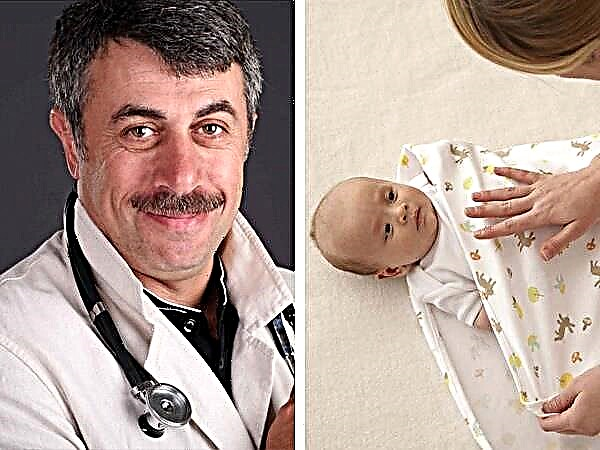When raising a baby, all parents are interested in the norms and terms according to which the child should develop. One of the most pressing questions for parents of a child who has reached 5 months of age is the ability of the baby to take an upright position. The age range is 6-8 months when the baby starts sitting.

Baby sitting
At what age does a child begin to sit
The earliest age for self-sitting is six months. Although the vast majority of children sit confidently closer to 8 months of age. The timing is individual and depends on the physical readiness of each individual child. The more the baby is in a horizontal position, the healthier his back will be. Therefore, pediatricians, including Komarovsky E.O., recommend in every possible way to encourage crawling, but not early sitting.
How to determine a child's willingness to sit
To understand what time the child sits down, you can only according to the state of the baby himself. To do this, parents must often watch him crawling. If this does not happen, the time when it is already possible to sit down the child has not yet come. It is important to understand that premature babies can learn such complex skills a little later than their peers. Such children first catch up with the state of their development up to the moment of "full-term", after which comes the turn of other skills.
Additional Information. If the baby starts on his own, without assistance, twisting one leg under him, to sit down, leaning his back or sideways on the nearest object, we can say that the time has come when you can sit the baby for a short time.

The child sat down
The developmental difference between boys and girls
Every child is different. The degree and speed of his development is influenced by both genes inherited from his parents and his personal abilities. One child can sit at the age of six months, the other at seven and a half months will only try to do it, constantly falling on its side.
Moreover, apart from the individuality of each child, there is a significant difference between boys and girls. We are not talking about obvious primary sex characteristics. From the first days of life, babies of different sexes have significant differences in the timing of the development of many skills. The main factor is the developing brain. In boys and girls, it grows and improves at absolutely different times, which affects the following differences:
- the girls pronounce the first words earlier - already at the age of 1 year, while the boys begin to master speech 2-3 months later;
- adaptation in a new society is easy for girls, they are sociable, even in infancy they get used to new relatives faster than boys;
- girls find it easier to switch from one activity to another, from a doll to an animal, while boys linger longer on one object or activity, more slowly and without much desire to switch their attention to something new;
- the visual memory of girls is directed to the details of the object; in boys, all attention is concentrated on the very essence of what they see;
- the right half of the brain, which is more responsible for mastering spatial skills, develops more slowly in girls than in boys, which explains the greater ability of men to navigate in space.
The same goes for physical development. Girls in infancy seem to be in a hurry to improve. They sit down earlier, then get up and take their first steps. However, the child's environment has a significant impact. If the baby is constantly held in his arms, not giving the opportunity to independently feel himself in space, such a child does not have the opportunity to master the motor function.

Learning to crawl
Important! Children, who are often laid on their stomachs, are allowed to play with toys, try to crawl, and build stronger back muscles earlier than others. In this regard, the age when such a child sits down is faster.
Skill development stages
A child's physical activity can be divided into several stages:
- The change in the position of the child from lying on his back to turning over on his stomach occurs by 2-3 months. This is the first and very important skill.
Attention! From the moment when the child has learned to roll over on his own, he cannot be left unattended for a long time, especially on an adult bed or sofa, because this furniture does not have boards that protect against falling.
- At the age of 3 and a half months, babies try to get up on all fours from a prone position. Moreover, such a short standing is often accompanied by swaying.
- Active crawling. Some babies, before starting to crawl on their own, try to stand on all fours, straightening their legs, that is, straightening their knees. Often, fragile arms fail, and the child falls, the main blow falls on the face. If the baby from time to time makes attempts to get on all fours, straightening his legs, it is better to underlay some kind of soft covering.

Stands with legs straightened
- Self seating.
How to teach a child to sit down
If the child is already 8 months old, and he still does not try to sit himself, you can help him with this by training his back muscles.
Exercises and games to help your child sit up
In order to prepare your child to sit down, you can use a variety of games aimed at strengthening the muscles of the spine. Because the child will sit down only when his back is ready for vertical loads.
Among the strengthening games, the most popular are:
- The child is placed on his stomach, and a bright toy is placed half a meter away from him. Even a three to four month old baby will try to get this toy. To achieve his goal, he will be forced to crawl a short distance.
- Use fitball exercises, for this, put the child on the ball, with his stomach down. Leaning on the handles, the child will try to keep the back straight, thereby training the muscles of the back and cervical spine. At some distance from the ball, lay out the bright toys and, rolling the baby forward on the ball, let him try to grab any of them. In the process of such a game, the back muscles located along the spine are also well trained.

On fitball
- Regular swimming in a full bath at home or in the pool. If it is not possible to visit the pool, or parents consider it unnecessary, you can successfully help the child with the development of the muscular skeleton at home. To do this, it is enough to bathe him in a bath every evening before going to bed, taking it with water to the brim. It is enough to help the child by keeping his head above the water. At the same time, the whole body should be immersed in water, where, thanks to uniform pressure in all directions, the baby can actively move as he wants, developing muscles.
- A baby who has learned to crawl needs to create conditions for improving this skill, for this, on the floor in the room where the child lives, lay out various bright interesting toys so that the baby can choose the most inviting one by crawling to it.
Precautions for Vertical Carrying
Many mothers prefer slings, backpacks and kangaroos to strollers. When wondering about their own comfort, few think properly about the safety for the child's health. This is one of the most important selection criteria. This is not to say which is better: a sling or a kangaroo backpack. All kinds of such devices for carrying a child have a right to exist. The main thing is not the method of transfer, but the correct choice of the size or type of device.
A sling scarf is good because, if used correctly, the child half-sits in it - half-lying. In this case, the load on the baby's back is distributed evenly over the entire area. There is an opportunity to master different winding schemes, in which the child can take an absolutely horizontal position, excluding the dangerous early sitting on the priest. You can also place the child both behind the mother (on her back) and in the front position.

In a sling lying
Kangaroo backpacks are also not harmful if chosen carefully. It is important to make a purchase with your child, trying on each model. The device straps should provide maximum support for the child's back. A situation should not be allowed where the entire load will fall on the pelvis or groin area. The child should evenly and tightly cling to the mother's body, which will completely remove the vertical load from the fragile spine.
Due to the fact that health problems can form, it is necessary to purchase even such entertainment as jumping, depending on how many months the child already begins to sit. Up to this point, even a short sitting down of the baby can lead to a disruption in the development of the skeleton in an initially healthy newborn.
Can I sit down specially
It often happens that older relatives can’t wait until the child can be planted. A highchair and walker have already been bought, and the baby is still in no hurry to sit steadily. Adults burn out with impatience, the child does not even try to sit down. Then the wiser generation decides to help the child in this difficult and long-awaited business. A four-month-old child is covered with pillows, forcibly seated, and his back and sides are propped up with bolsters.
Why you can't sit down ahead of time
If the child does not sit down himself, there is no need to help him in this. Only after his skeleton and muscle mass are ready for vertical loads, he can sit down. Stressing the skeleton before it gets stronger can lead to health problems later in life.

Scoliosis
The most common disorders of the musculoskeletal system, which led to early unloading of the child:
- scoliosis;
- anomalies in the development of intervertebral discs;
- herniated disc;
- pain syndrome;
- pinched spinal nerve.
When asked how many months a child can be planted, the baby himself will answer the parents: from the moment when he comes to this. Instead of putting the baby on the highchair, it is better to give preference to active crawling and swimming. After waiting for the maturity of the child's muscular skeleton and spine, it will be possible with pleasure to safely put him at the table, without fear for his health.



